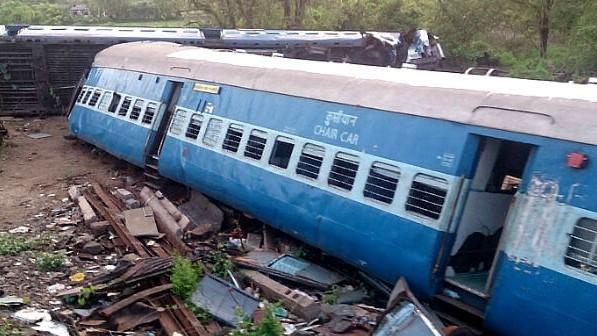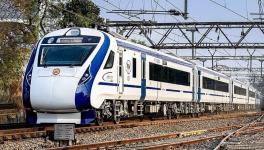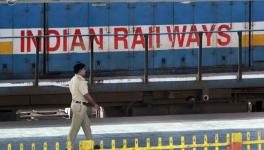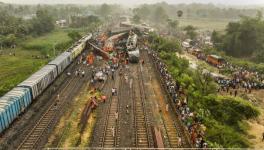NITI Aayog Questions Railways Safety Data on Zero Deaths

Representational image. | Image Courtesy: Factly
New Delhi: Taking note of the Indian Railways' claim of zero deaths in the current fiscal and only five deaths in 2019-20, NITI Aayog has question the reliability of the data while pointing towards over thousands deaths in Mumbai suburban section every year.
The NITI Aayog has also questioned the significant expenditure incurred from the specially created fund to strengthen the safety mechanism and observed the absence of any advanced "technologies introduced by Indian Railways for the purposes of improving safety".
In the quarterly review meeting of Rashtriya Rail Sanraksha Kosh (RRSK) in the last week of July, chaired by NITI Aayog CEO Amitabh Kant, a presentation was made which highlighted the safety works undertaken as well as their impact on railway safety. "As per the data presented by the Indian Railways, there has been a noticeable improvement in railway safety," Kant said in a letter to Chairman Railway Board (CRB) VK Yadav after the meeting.
However, Kant pointed out in his letter to Yadav, "The presentation highlights a total of five deaths recorded in 2019-20 and zero deaths in the current fiscal years. Is this a realistic record? In the Mumbai suburban network over 2,000 people lose their lives every year. It was informed that these deaths are caused on accounts of trespassing and therefore not counted."
"I would like to draw your attention to the fact that many of these deaths are caused by people falling overboard or from the platform on to the tracks. Hence, this should not be excluded from the purview of RRSK. It should be ideally recorded officially," the CEO added.
Seeking concerted efforts to prevent deaths in the suburban service, the CEO requested for investment in the design of coaches on suburbarban networks such as Mumbai “which must have automated doors to prevent such occurrences”.
The letter also highlighted that despite spending nearly Rs 55,000 crore on railway safety under RRSK so far, there has been no significant technological changes for improving safety. Instead resource allocations are being spread too thinly, as indicated by “the annual fund provision of Rs 20,000 crore allocated to 9,000 works under 14 Plan Heads”, which in turn fails to bring any significant improvement.
Also read: Blood on Tracks: Railways Yet to Compensate,May Term Incident as ‘Trespassing’
The money under RRSK for Signalling & Telecom works is to be utilised for installation of train protection and warning system (TPWS), train collision avoidance systems (TCAS) besides others. These are extremely important, particularly in winters when fog cripples the railway network.
But, the letter said, “In 2019-20, 93% of the funds allotted for this purpose were utilised. However, it appears that most of the expenditure has been incurred in replacement of old signalling equipment and no money has been spent for bringing in the latest globally accepted signalling technologies like ETCS Level 2 or even the more advanced ones. Introduction of such a system would have enabled addition of line capacity by at least 50% thereby not only reducing congestion in the network but also offset expenditure on other capacity augmentation works."
Kant further wrote, "The funds are also being utilised for procurement of rolling stock across passenger and freight segments including diesel locos. The expenditure under this head exceeds 300% of the sanctioned amount in the fiscal year. Considering the fact that technology of rolling stock in IR is almost three decades old, in all segments including locos, and the fact that there are no visible efforts to bring new technologies in production units."
Suggesting a rethinking on utilisation of safety funds, Kant said that the strategy of spending large sums of money on improvement of design of rolling stock from the scarce safety fund needs an immediate relook.
The letter has also questioned the rationale behind spending on diesel loco maintenance, “while IR plans to achieve cent percent electrification by 2020 and also to decarbonise by 2030”.
On the Railways ambitious 160 kmph speed project for Delhi-Mumbai and Delhi-Howrah corridors, NITI Aayog maintained that, “These are extremely capital intensive projects. If so much progress has been made under RRSK on safety works such as track renewals, signalling which will greatly benefit such projects, the expenditure on these projects should also reduce. The possible dovetailing of RRSK funds with the expenditure on such projects needs to be suitably factored in bringing down Capex of these projects."
In response to NITI Aayog's observation, Railways maintain that RRSK is now in its third year since its inception and a number of works have been undertaken for improvement of railway safety. However, Railways reiterated that in 2019-20, a total five deaths were recorded due to train accidents. None of these deaths was that of a bonafide railway passenger. They were either railway employees or contractual labour.
Also read: COVID-19: New Rail Projects Barring Safety Work to Be Held in Abeyance
It further maintained that the large numbers of deaths taking place on the Mumbai suburban are not considered in the statistics pertaining to deaths by train accidents but, they are recorded and maintained officially for payment of claims, etc.
Making special efforts to eliminate trespassing in suburban areas, the Railways has targeted construction of 1,500 foot overbridges (FOB) in the period 2019-24. Out of these more than 500 have already been commissioned. Railways are also providing escalators to facilitate convenient crossing of tracks to augment FOB capacity.
The Railways is also investing as part of Mumbai Urban Transport project-3 on trespass control through fencing and FOB construction. To reduce crowding on the platform, a communication-based train control system system is being introduced to reduce headway between trains and increase the overall capacity of the Mumbai suburban system. The new rolling stock will have automatic door closing and opening which will reduce the probability of passengers falling out of coaches.
On ETCS, Railways has said that adoption of the system has been considered on its network for improving safety. TPWS system based on ETCS Level 1 has since been implemented on 345 route km on Southern Railway, 28 km on Metro Rail Kolkata and 200 km in North Central Railway.
Further, four pilot projects on the golden quadrilateral routes totalling 640 kms under RRSK have ben taken up for provision of ETCS Level 2.
It further said escalators and lifts were added after the Elphinstone FOB stampede tragedy. This was done primarily to augment FOB capacity and also make it more convenient for rail users to cross rail tracks rather than opt for crossing by way of trespassing.
Responding to the expenditure on diesel locos spares and consumables, the Railways said that such measures have been stopped. Most of the expenditure is on infrastructure in maintenance sheds which will be used later by electric locos.
Get the latest reports & analysis with people's perspective on Protests, movements & deep analytical videos, discussions of the current affairs in your Telegram app. Subscribe to NewsClick's Telegram channel & get Real-Time updates on stories, as they get published on our website.
























